Long Island University has a campaign (in 2013) called “Find Out How Good You Really Are.” When I went to college, I found out I wasn’t all that good. I persevered and finally got a diploma. Maybe I should have gone to City College — just the architecture alone might have been better inspiration. In September 2012 I wandered down Convent Avenue through the heart of the campus, mainly because I had never done that before, and found the place a wonderworld of beautiful buildings, old and new.
The City College campus, in part, replaced the campus of the Catholic Society of the Sacred Heart, which once stood between Convent Avenue and St. Nicholas Terrace between West 130-135th Streets, called the South Campus. It’s the North Campus, though, that has the most monumental of CCNY’s architecture, much of it designed by George B. Post and built from 1902-1907.
WAYFARING MAP: MORNINGSIDE/CONVENT from 113th-140th
Baskerville Hall
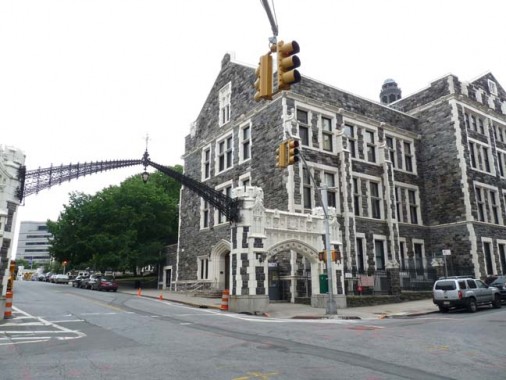
Accompanied by one of the handsome concrete and metal arched gates (this one is the Alexander Hamilton Gate; the first Treasure Secretary lived nearby (see below) that cross over Convent Avenue at West 140th Street, Baskerville Hall was originally housed CCNY’s chemistry labs and is named for a renowned chemistry professor, Charles Baskerville. When constructed in 1902 this was a state of the art chemistry research facility. Today, it is home to the High School for Math, Science and Engineering as well as student organization offices.
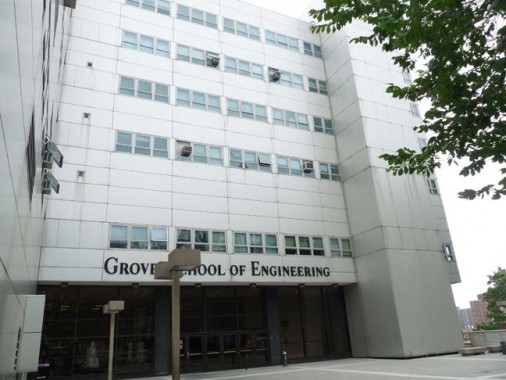
Baskerville Hall is catercorner from the Grove School of Engineering, which looks somewhat newer than it is. It was constructed in 1962, but given a new facade in 1996. The original exterior was white glazed brick while the modern surface is aluminum. As the City College School of Technology, Grove was established in 1919. It was named for Andrew Grove (class of 1960), the founder of computer chip manufacturer Intel, Inc., who endowed the school with a $26 million donation.
Shepard Hall
CCNY’s Shepard Hall is the anchor building of the campus, occupying a plot between Convent Avenue, St. Nicholas Terrace and West 140th Street. It is anchor-shaped with two wings proceeding from a central section. The 185′ x 89′ x 63′ Great Hall, which can host over 1,000 people, is the centerpiece of Shepard Hall and is dominated by twelve massive columns and Gothic peaked windows. Shepard Hall hosts CCNY’s Schools of Architecture, Urban Design and Landscape Architecture, the department of Humanities, a music library, the college’s alumni association as well as several other offices.
A whimsical touch imparted by Post is the presence of stone grotesques and gremlins on the exteriors. One of them holds a model of Shepard Hall!
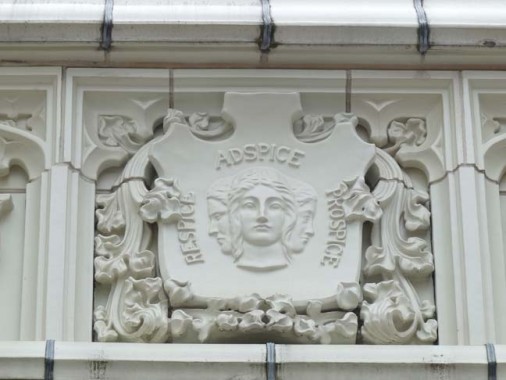
The City College insignia is three female heads with the motto in Latin, “Respice, Adspice, Prospice.” The faces represent the “Three Provinces of Scholarship—the Past, the Present and the Future.”
“Respice, Adspice, Prospice,” the City College motto, is translated as “look back” (respice), “look at” (adspice), and “look ahead” (prospice).
Shepard Hall’s front entrance is on St. Nicholas Terrace, which runs along the crest of the high hill facing St. Nicholas Park. A recent addition to the park is the Hamilton Grange, which was recently moved to the park from its previous address on Convent Avenue and West 141st Street.

Wingate Hall (left) and Harris Hall face Convent Avenue in the line of West 138th Street. Along with Shepard, Compton and Baskerville Halls it completes the great quintet of buildings designed by George Post for the CCNY uptown campus in the early 1900s.
Wingate Hall was designed as CCNY’s phys ed building and contains a swimming pool, gymnasium and campus offices. Harris Hall, named for the founder of City College (in 1847), businessman and president of the Board of Education Townsend Harris, contained an 800-seat assembly hall and college offices. It is today a center of biomedical education.
General Alexander S. Webb
General Alexander Webb (1835-1911) was a West Point graduate and played a central role in the Union victory at Gettysburg. The statue honoring him here, by J. Massey Rhind, is a copy of the one that stands at Gettysburg. After the war, Webb was an educator at West Point and became the second President of CCNY in 1869, serving in that post for 33 years.
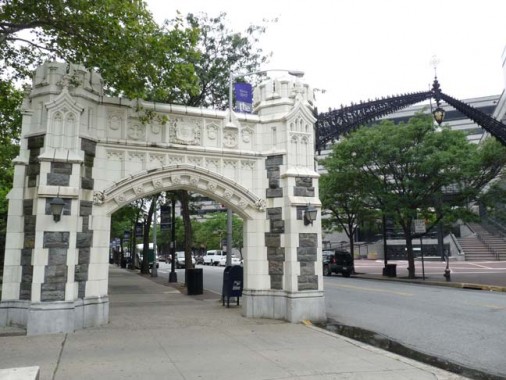
The George Washington campus gate crosses Convent Avenue in the line of West 138th Street.
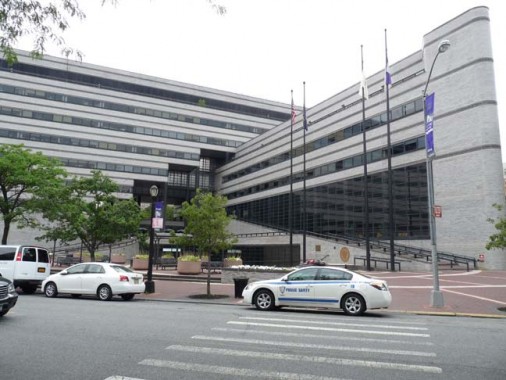
The North Academic Center replaced the old Lewisohn Stadium, formerly a major concert venue, in 1983. The NAC building houses hundreds of classrooms, two cafeterias, the Cohen Library, student lounges and centers, administrative offices, and a number of computer installations. Designed by architect John Carl Warnecke, the building has received criticism for its lack of design and outsize scale in comparison to the surrounding neighborhood. wikipedia
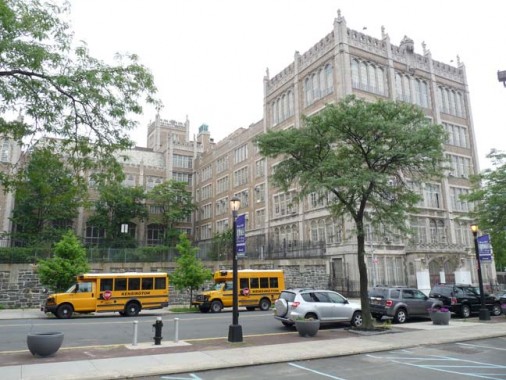
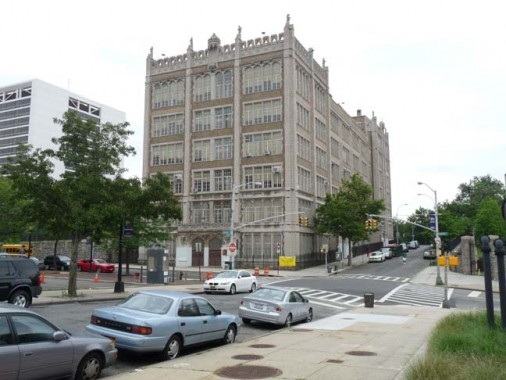
A. Philip Randolph High School, named for the civil rights leader and union organizer, dominates the northeast corner of Convent Avenue and East 135th. It is a neo-Gothic building completed in 1926. It spent many decades as the High School of Music and Art.
Croton Gatehouse

When I first encountered this Croton Aqueduct gatehouse in the late 1990s, I photographed it in the decrepit condition it was in then, abandoned and surrounded by weeds…
But in 2006 it was completely renovated and now seves as the Harlem Stage Gatehouse, where the waterworks in the subterranean chambers have been replaced by performance stages. Water formerly flowed through this building from High Bridge and the aqueduct north of it, directed by gravity (the aqueduct ran slightly downhill from upstate) through a series of pipes and through a number of gatehouses like this one to the Croton Receiving station at 5th Avenue and 42nd Street — replaced in 1912 by the Public Library and its lions.
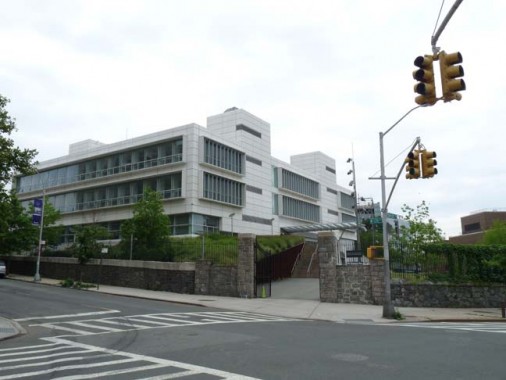
On the southeast corner of West 135th is the Bernard and Anne Spitzer School of Architecture, rebuilt from the campus’s old Y building by Rafael Vinoly in 2009.
Wandering around the undeveloped area west of the hall, you arrive at…
Remembrance Rock
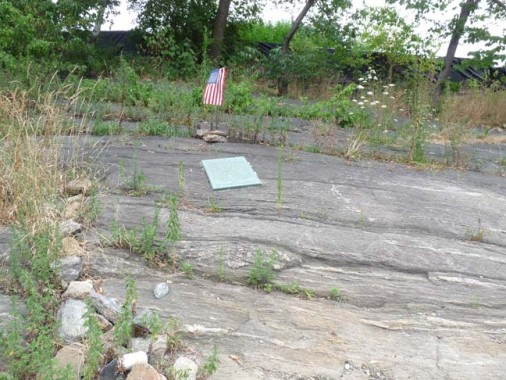
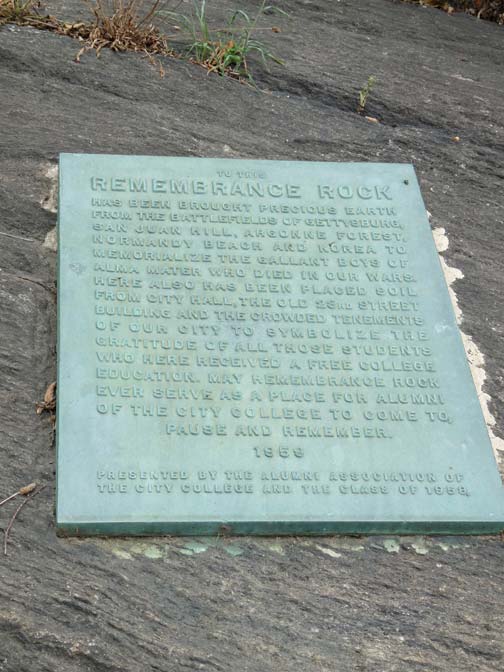
Located between the Spitzer School and Convent Hill, this tablet covers a mixture of soils from historically sensitive locations such as the Ardennes battlefield, the Lower East Side, Gettysburg, and other places. It was placed here in 1958. — CCNY graduate and FNY correspondent Sergey Kadinsky
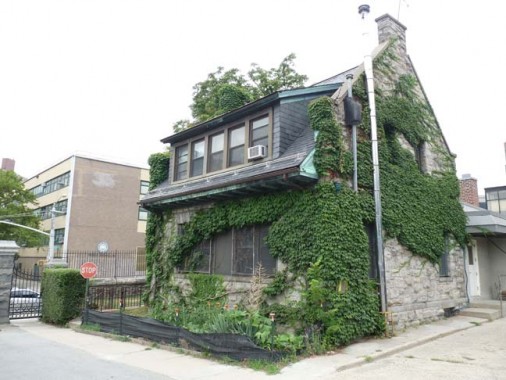
I exited the campus at Convent Avenue and West 133rd, at this unprepossessing little ivied building that nevertheless was once the official residence of the CCNY president. It is officially called the Schiff House and was constructed in 1912.
This wasn’t meant to be a comprehensive view of CCNY’s classic architecture. For that I recommend CCNY’s 100 Years on Hamilton Heights site.
More on Convent Avenue
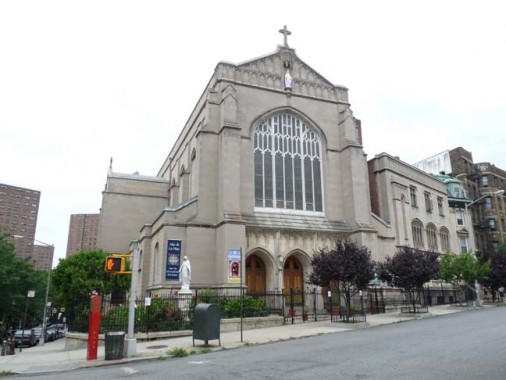
Despite the disappearance of the original Convent of the Society of the Sacred Heart, Convent Avenue retains a number of sacred sites, including the Church of the Annunciation (referring to the New Testament story of the angel Gabriel’s announcement to Mary that she would be the mother of Christ) at West 131st. The parish was founded in 1852, the original church building was dedicated the following year, and the “new” church seen here was dedicated in 1907.
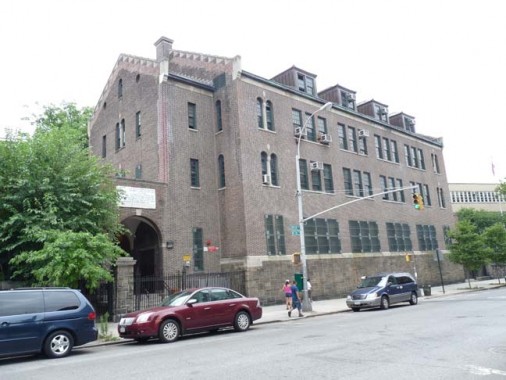
The Mott Hall School, Convent Avenue and West 131st, has been one of the great chess hotbeds in the NYC public schools system:
Mott Hall, a.k.a. Manhattan P.S./I.S. 223, has been considered one of the top public-school chess programs not only in New York but the entire country. From 1997 to 2001, with [Jerald] Times as coach, Mott Hall had won three national championships. Back then, the school was an obligatory stop on the value-of-chess-in-the-schools tour. Bill Gates came uptown, declaring chess excellent for raising standardized-test scores. Prince Andrew arrived in a limo. New Yorker editor David Remnick was principal for a day, which he spent getting checkmated by sixth-graders before refusing to play a fourth-grader because enough was enough. NY Magazine
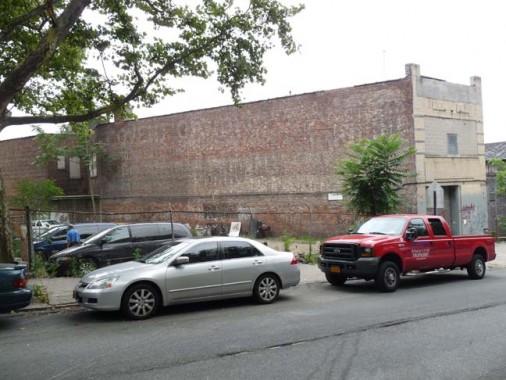
A pair of “faded ads” can be seen in the Covent Avenue vicinity. There’s this one, mostly faded to nonintelligibility, on West 130th just west of Convent…
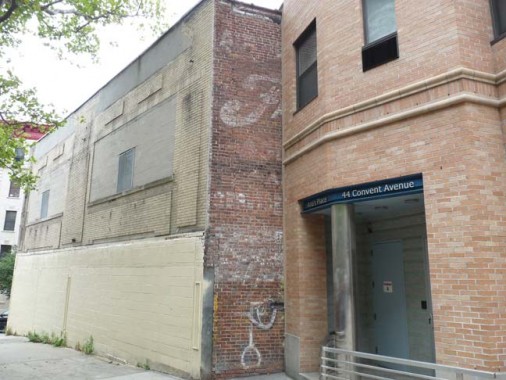
… and this one, on the corner building on West 129th. A newer set of apartment buildings have obscured it and now only the script “F” is recognizable. It could have been a Ford ad.
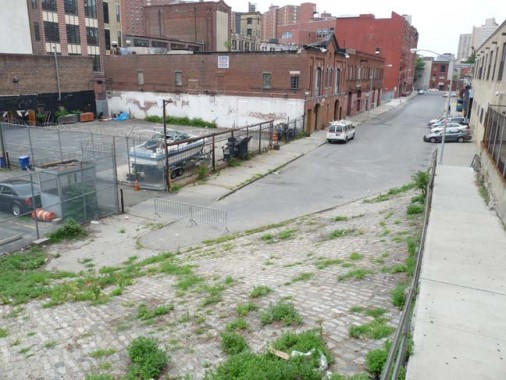
West 128th Street doesn’t quite make it to Convent Avenue. The grade was considered too steep. A ramp is there for pedestrians.
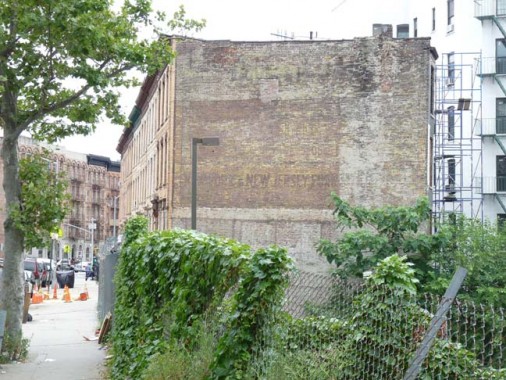
Another ad, facing north on Convent has faded to a condition beyond readability. Only “New Jersey” is legible at present.

Convent Avenue is actually a northern extension of Morningside Avenue. North of Central Park, the perfect John Randel gridiron plan conceived of in 1811 breaks down, because Manhattan narrows considerably and is also a lot hillier. When you have reached West 127th Street, 1st, 2nd and 3rd Avenues still intersect it, as well as Park (4th), 5th, Lenox/Malcolm X Blvd. (6th), Adam Clayton Powell Boulevard and Frederick Douglass Boulevard (7th and 8th.). But you also find north-south avenues that don’t correspond to numbered avenues, like Morningside, Convent, Manhattan, Bradhurst, Wadsworth, and St. Nicholas (which follows a colonial-era path already in use when Randel surveyed the island).
Here the beginnings of Convent Avenue are seen at West 127th where Morningside Avenue ends.
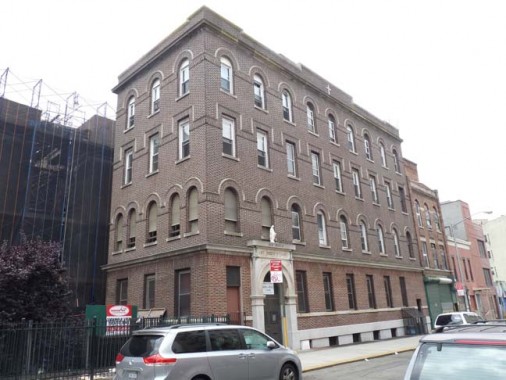
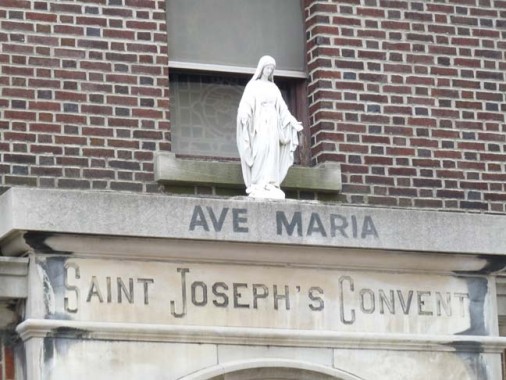
St. Joseph’s Convent, now the Queen of Peace Home on West 127th west of Morningside Avenue, isn’t the convent of Convent Avenue, as I had thought when walking the route in 2012.
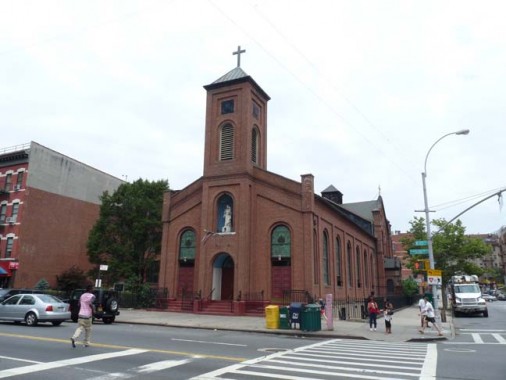
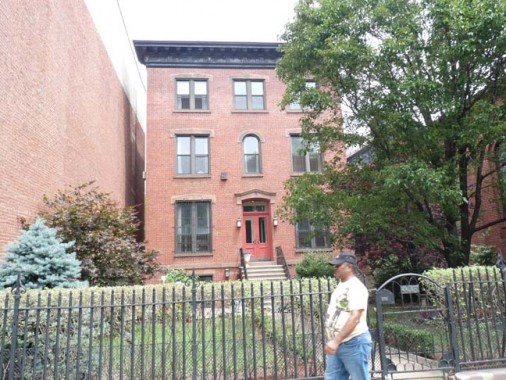
It’s more likely connected with St. Joseph’s Church and neat parish house on West 125th and Morningside Avenue. The church and its parish go back to 1860; the first Corpus Christi procession was held at the church.
Roosevelt Triangle is located at West 125th Street (Martin Luther King Blvd.) and Morningside Avenue.
The bronze sculpture that now ornaments Roosevelt triangle was donated by the Peter Putnam-Mildred Andrews Fund in 1976. This abstract piece, constructed from welded bronze plate and known as the Harlem Hybrid, is the work of Richard Hunt. Hunt is an African American artist with an international reputation. He has produced a number of public sculptures, most in his native Chicago, in a career that has spanned over thirty years. In New York, Hunt has exhibited his work at the Museum of Modern Art and the Studio Museum of Harlem. Although Hunt’s work is purely abstract and usually executed in metal or discarded machine-made parts, admirers find consistent evocations of plant life and geological formations in his work. NYC Parks
To wind up the walk, I went south on Morningside Avenue, which is actually one of the shortest of Manhattan’s north-south avenues, running just 14 blocks from Manhattan Avenue and West 113th to West 127th and Convent, running along Morningside Park.
If you look at the map, 30-acre Morningside Park can be seen as a northern fingerlike extension of Central Park, extending as it does from Cathedral Parkway (West 110th Street) to West 123rd Street roughly between Manhattan and Morningside Avenues and Morningside Drive. And, it was designed by Central Park architects Frederick Olmsted and Calvert Vaux, opening in 1887; Jacob Wrey Mould, who designed the carvings at Bethesda Terrace in Central Park, finished Olmsted and Vaux’ plan and designed the masonry wall along Morningside Drive. Located along a steep cliff, the park takes its name from the morning sun that illuminates the cliffs.
Here we find Frédéric-Auguste Bartholdi’s 1900 statue of George Washington and France’s Marquis de Lafayette. The statue is a copy of another one located in Paris; Batholdi, whose most famed work is Liberty Enlightening the World in New York Harbor, had likely executed the work in 1890 in honor of the two generals who had worked closely to secure American independence.
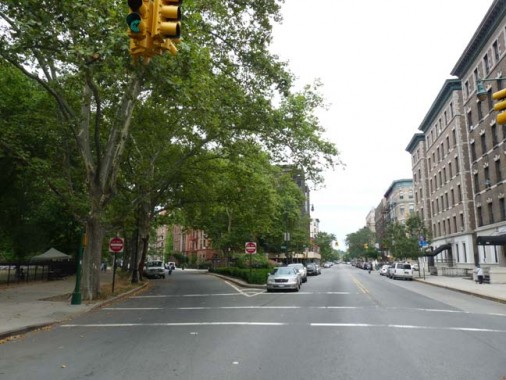
Manhattan Avenue (right) and Morningside. When you come to a fork in the road, as Yogi says, take it.
5/19/13

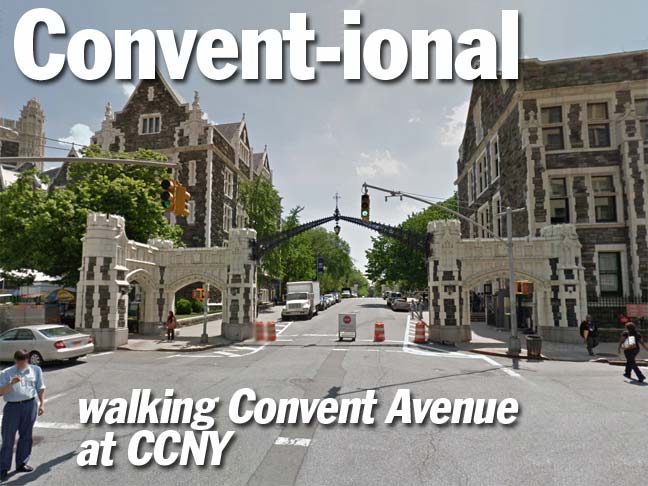
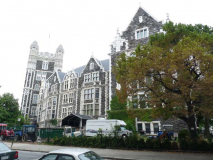
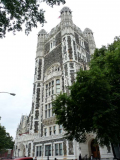
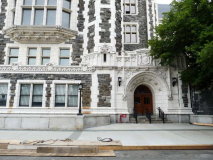
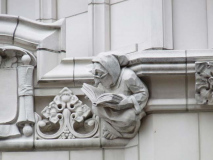
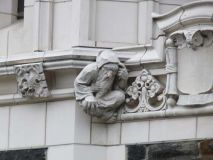
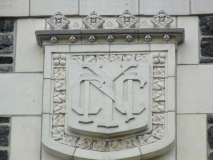
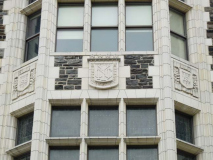
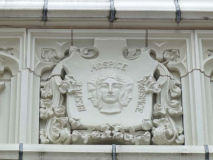
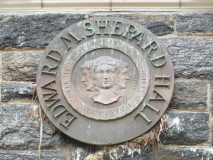
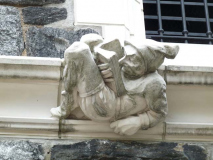
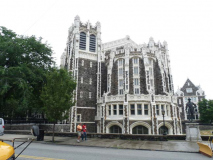
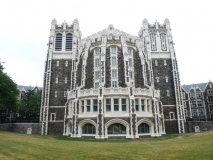
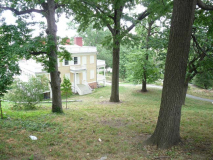
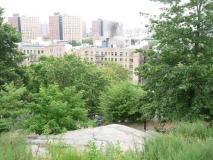
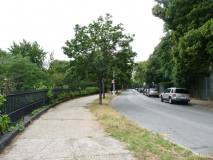
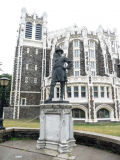
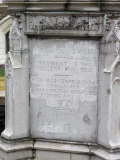
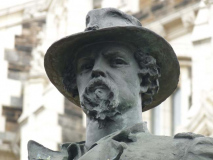
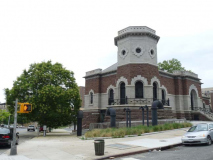
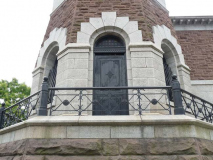
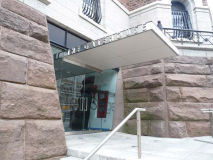
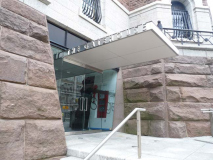
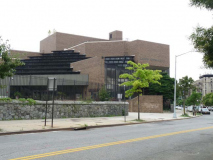
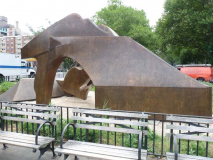
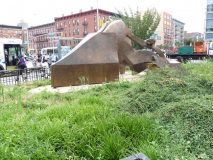


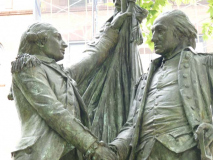
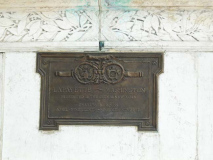
13 comments
Some of the college campus reminds me of the yale campus in new haven, ct.
The refacing of the E-School fairly shouts out the question– was the planning for how it was to go done in-house? Nothing like a good practical example for the students, I always say.
Was this avenue named Convent Avenue possibly for a convent that was probably there originally, or was its name given for another reason?
See the article…
I don’t know how the awful, pedestrian translation of the CCNY Motto Respice, Adspice, Prospice as look back, look at and look ahead came to replace the former rendition of Look to the Past, Look to the Present, Look to the Future, but the responsible party for that desecration should do a little looking themselves – for a new job.
Donald J. Gilligan ’62
Just looking at the campus by itself can almost make you feel as if you aren’t in Manhattan but in a typical college town.
I was a CCNY student in the late 60’s and early 70’s. The buildings above were the “North Campus” and are thankfully restored. The “South Campus”, an eclectic mixture of odd buildings is completely gone–really no trace except for Mott Hall on the side.The main South Campus building, Finley Hall, was negatively famous as the site of a fire during student riots of the late 60’s, and the picture is often used as a symbol of that time.
Brings back memories. I went to CCNY BSEE Class of 1973.
The narrowing of W 128th to a triangular point, rather than a typical street end, is interesting. I suppose if you have to turn around a car you best do it before that point.
Oh, my! the metalwork on those gates are really impressive….and more over, rather unique. I’ve never seen anything like that…
[…] Unconventional: In our latest podcast on the history of the Limelight, I made mention of the number of convents in New York City over the year. Well, Forgotten NY goes one further and does a tour of the street actually named for one — Convent Avenue – featuring the beautiful neo-Gothic architecture of City College. [Forgotten New York] […]
[…] Unconventional: In our latest podcast on the history of the Limelight, I made mention of the number of convents in New York City over the year. Well, Forgotten NY goes one further and does a tour of the street actually named for one — Convent Avenue — featuring the beautiful neo-Gothic architecture of City College. [Forgotten New York] […]
I was looking for Lutheran Hospital, Convent Av near 144 Street.